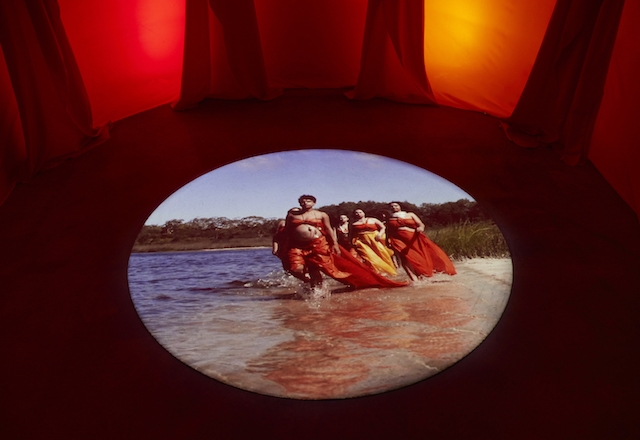It is a longstanding critique of Australia’s museums that they have not done enough to advance local and Indigenous artists. So as the wider Western artworld reevaluates the representation of minority histories, three of Sydney’s largest institutions devised The National in an attempt to redress the balance. Falling on the off years of the Biennale of Sydney, the exhibition partnership attempts both to stabilise Sydney’s position as Australia’s cultural capital and deliver a more encompassing national art history: one that prioritises, following the marketing copy, the buzzwords of ‘difference’, ‘hybridity’ and ‘collaboration’.
With this second edition of three of the biennial project, a new set of curators – Clothilde Bullen and Anna Davis at the Museum of Contemporary Art, Australia; Daniel Mudie Cunningham at Carriageworks; and Isobel Parker Philip at the Art Gallery of New South Wales – have learned from the mistakes of the first, which did not do enough to accommodate those perspectives. The result is an eclectic selection that complicates Australian concepts of the nation and its relationship to history.
The Museum of Contemporary Art takes the Aboriginal Australian struggle for equality and reminds the viewer that these injustices are not settled in history but implicate wider contemporary society. Painting on disused canvas mailbags, Kunmanara (Mumu Mike) Williams’s Kamantaku Tjukurpa wiya (2018) memorialises the artist’s ancestors, murdered during the frontier wars (1788–1934). Combining Aboriginal motifs with maps of the land and phrases from the Pitjantjatjara language, the work draws on the colonial practice of posting poisoned rations to remote Aboriginal communities. The large wallhanging, made up of sewn-together mailbags, is a reminder that the very mapping of modern Australia is a continuation of the violence in itself.
Hannah Brontë’s video installation Heala (2018) is a glowing orange chamber. Onto a disc of sand on the floor is projected a video featuring six minutes of commanding rap, speech and singing by a multigenerational chorus of women of colour. Addressing the experiences of Aboriginal women, it is a cathartic meditation on what is lost and gained in the aftermath of trauma, both individual and communal. Eugenia Lim’s The Australian Ugliness (2019), meanwhile, is housed in a canary-yellow ‘fishbowl’ structure – a reimagining of Anglo-Australian architect Robin Boyd’s last building project, Neptune’s Fishbowl, completed in 1970 in South Yarra. The three-channel video follows the artist – here named ‘The Ambassador’ – through culturally and historically significant sites across Australia. The work suggests that, while she is permitted to enter these public and private sites, she is never invited to stay; that Australian national identity has been built on exclusion.
At the Art Gallery of New South Wales, Mira Gojak’s Exhaled Weight (2019) comprises a series of curious bulbous steel sculptures, wrapped with bundles of sky-blue yarn. Extended into a straight vertical line, the length of yarn would stretch from ground level to the top of the stratosphere, where sky bleeds into space. It’s one glorious example of this section of the exhibition’s focus on the simultaneously mundane and transcendental properties of materials. Elsewhere in the building, a number of different interventions collude with the building’s architecture. Andrew Hazelwinkel’s Part 1, The Emissaries: Keepers of Our Stories from The Ongoing Remains (3 Parts) (2019) comprises replications of Italian politician Niccolò da Uzzano’s 1431 death mask. Situated in three different spaces – each responding to the galleries of colonial history painting – Hazelwinkel’s sculptures of an opponent to the Medici family might allude to the relationship between art and power. Rushdi Anwar’s Irhal (Expel), Hope and the Sorrow of Displacement (2013–) gives form to his own experiences of exile as part of the Kurdish diaspora. For this ‘ongoing’ sculpture, chairs are burnt to a crisp and then stacked to a steep, tottering height. These ruined symbols of support and domesticity reflect on those forced to flee their homes, but the organisation into a structure – however precarious – seems to offer the possibility of hope.
Spotlighted in the gloom of Carriageworks is Eric Bridgeman’s monumental painting and textile work Sikiram | Büng | Scrum (2019). Blending motifs from Papua New Guinean shields from the Wahgi Valley with those taken from rugby jerseys, a reference to the region’s love of rugby league, Bridgeman’s ode to his Melanesian upbringing asks how traditional practices adapt to a changing world. The influence of social media on that process is a feature of the Carriageworks exhibition, at the entrance to which is Nat Thomas’s Postcard from the Edge (2019). The visitor is invited to lie down on (and cling to the edge of) a platform in front of a backdrop that creates, to a camera placed at ground level, the cinematic illusion that one is dangling from the edge of a building. It reads like a comment on the reliance of not only social media, but also exhibition-making, on fabricated drama. By using this show as a platform to promote alternative art histories, and resisting the temptation to impose a grandiose prospectus upon it, the curators largely avoid that trap. Instead they put forward a challenge to past and present thinking about Australian art, which alone is worth celebrating.
The National 2019: New Australian Art at Carriageworks, Museum of Contemporary Art Australia and Art Gallery of New South Wales, Sydney through 23 June/21 July (dates vary by venue)
From the Summer 2019 issue of Artreview Asia
